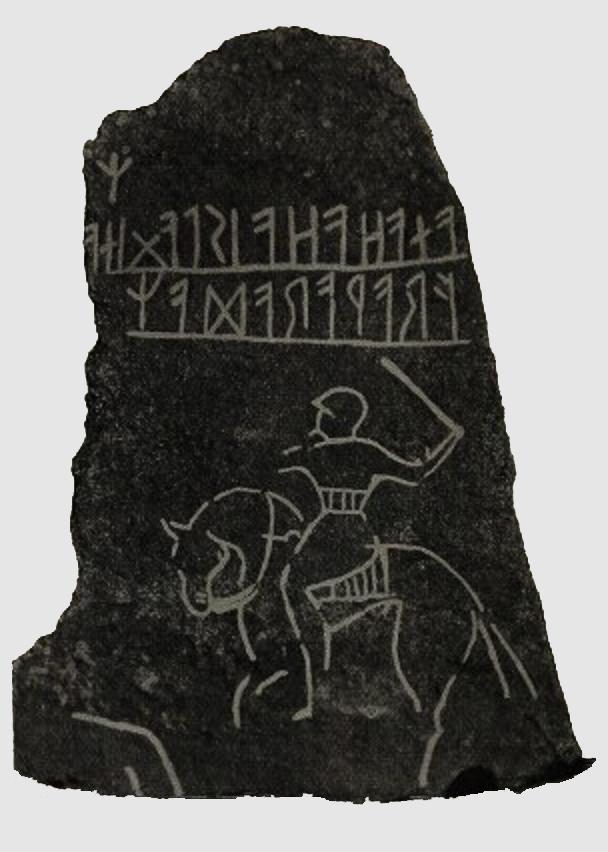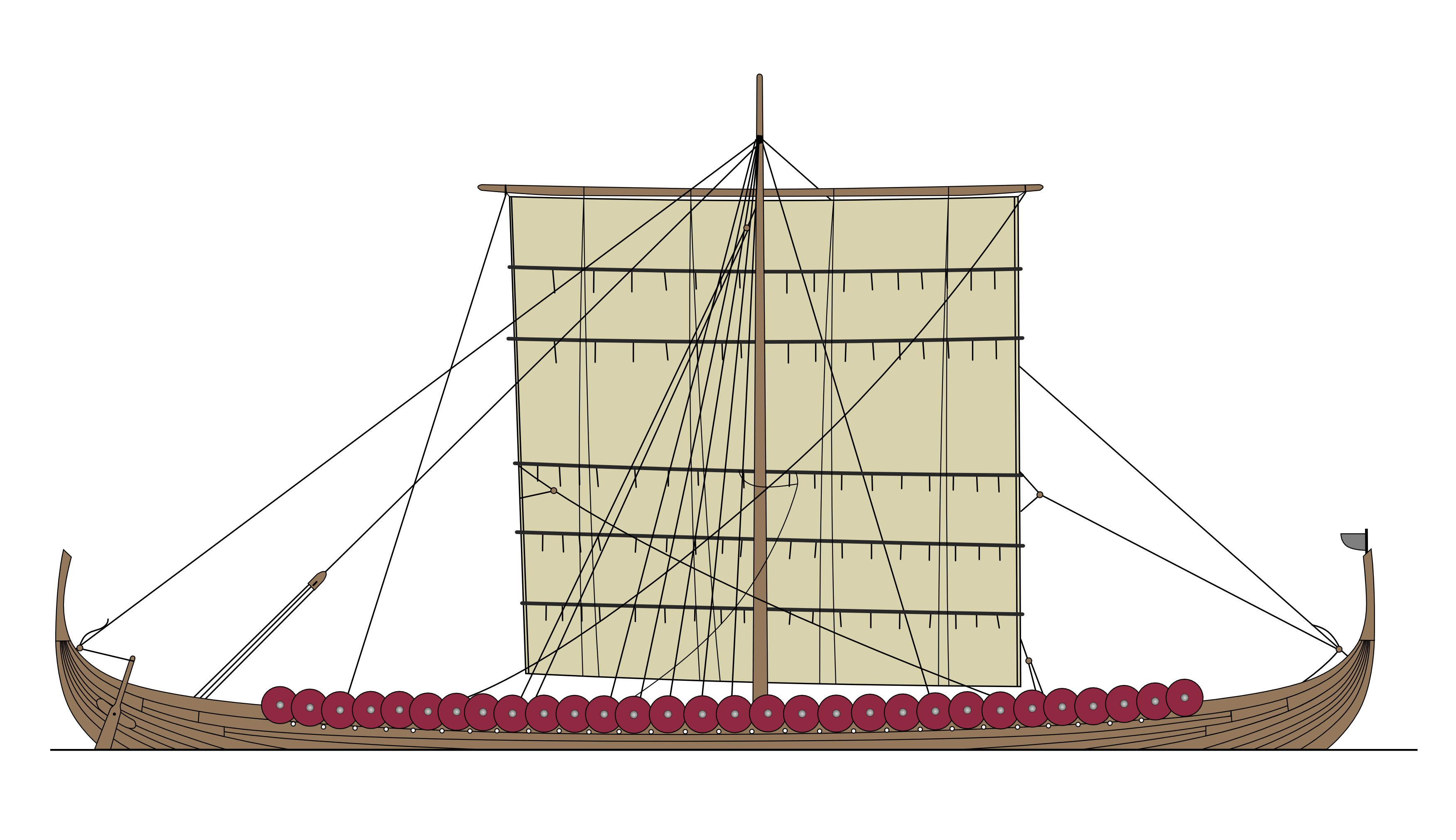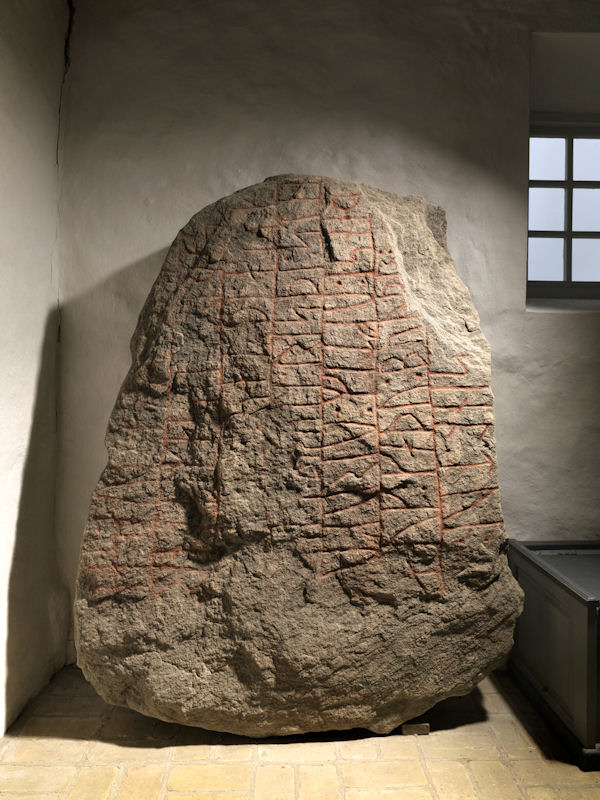|
Tryggevælde Runestone
Tryggevælde Runestone, designated as DR 230 under Rundata, is a runestone housed in the National Museum of Denmark, in Copenhagen. It is classified as being carved in runestone style RAK, and is dated to about 900 CE. Description In 1555, the runestone was moved from a barrow to the Tryggevælde estate on Zealand. It came to Copenhagen in 1810. There are several holes on the runestone, but no one knows why. Ragnhild, who raised the runestone, also had Glavendrup stone (DR 209) made after another husband named Alle. That runestone is located at a barrow and a stone ship in Glavendrup on the island of Funen. Both the Glavendrup and Tryggevælde runestones were made by the same runemaster, Sote. The inscription ends with a curse against anyone who would destroy or move the runestone that is similar to the ones found on the Glavendrup stone the Sønder Vinge runestone 2 and the Glemminge stone and the Saleby Runestone in Sweden. There is some disagreement regarding the translati ... [...More Info...] [...Related Items...] OR: [Wikipedia] [Google] [Baidu] |
Runemaster
A runemaster or runecarver is a specialist in making runestones. Description More than 100 names of runemasters are known from Viking Age Sweden with most of them from 11th-century eastern Svealand.The article ''Runristare'' in ''Nationalencyklopedin'' (1995). Many anonymous runestones have more or less securely been attributed to these runemasters. During the 11th century, when most runestones were raised, there were a few professional runemasters. They and their apprentices were contracted to make runestones and when the work was finished, they sometimes signed the stone with the name of the runemaster. Many of the uncovered runic inscriptions have likely been completed by non-professional runecarvers for the practical purposes of burial rites or record-keeping. Due to the depictions of daily life, many of the nonprofessional runecarvers could have been anything from pirates to soldiers, merchants, or farmers. The layout of Scandinavian towns provided centers where craftspeople ... [...More Info...] [...Related Items...] OR: [Wikipedia] [Google] [Baidu] |
Runestones With Curses
A runestone is typically a raised stone with a runic inscription, but the term can also be applied to inscriptions on boulders and on bedrock. The tradition began in the 4th century and lasted into the 12th century, but most of the runestones date from the late Viking Age. Most runestones are located in Scandinavia, but there are also scattered runestones in locations that were visited by Norsemen during the Viking Age. Runestones are often memorials to dead men. Runestones were usually brightly coloured when erected, though this is no longer evident as the colour has worn off. The vast majority of runestones are found in Sweden. History The tradition of raising stones that had runic inscriptions first appeared in the 4th and 5th century, in Norway and Sweden, and these early runestones were usually placed next to graves. The earliest Danish runestones appeared in the 8th and 9th centuries, and there are about 50 runestones from the Migration Period in Scandinavia. Most rune ... [...More Info...] [...Related Items...] OR: [Wikipedia] [Google] [Baidu] |
Runestones In Denmark
A runestone is typically a raised stone with a runic inscription, but the term can also be applied to inscriptions on boulders and on bedrock. The tradition began in the 4th century and lasted into the 12th century, but most of the runestones date from the late Viking Age. Most runestones are located in Scandinavia, but there are also scattered runestones in locations that were visited by Norsemen during the Viking Age. Runestones are often memorials to dead men. Runestones were usually brightly coloured when erected, though this is no longer evident as the colour has worn off. The vast majority of runestones are found in Sweden. History The tradition of raising stones that had runic inscriptions first appeared in the 4th and 5th century, in Norway and Sweden, and these early runestones were usually placed next to graves. The earliest Danish runestones appeared in the 8th and 9th centuries, and there are about 50 runestones from the Migration Period in Scandinavia. Most runeston ... [...More Info...] [...Related Items...] OR: [Wikipedia] [Google] [Baidu] |
Longship
Longships were a type of specialised Scandinavian warships that have a long history in Scandinavia, with their existence being archaeologically proven and documented from at least the fourth century BC. Originally invented and used by the Norsemen (commonly known as the Vikings) for commerce, exploration, and warfare during the Viking Age, many of the longship's characteristics were adopted by other cultures, like Anglo-Saxons, and continued to influence shipbuilding for centuries. The longship's design evolved over many centuries, and continuing up until the sixth century with clinker-built ships like Nydam. The longship appeared in its complete form between the ninth and 13th centuries. The character and appearance of these ships have been reflected in Scandinavian boatbuilding traditions to the present day. The particular skills and methods employed in making longships are still used worldwide, often with modern adaptations. They were all made out of wood, with cloth sails ... [...More Info...] [...Related Items...] OR: [Wikipedia] [Google] [Baidu] |
Christianity
Christianity is an Abrahamic monotheistic religion based on the life and teachings of Jesus of Nazareth. It is the world's largest and most widespread religion with roughly 2.38 billion followers representing one-third of the global population. Its adherents, known as Christians, are estimated to make up a majority of the population in 157 countries and territories, and believe that Jesus is the Son of God, whose coming as the messiah was prophesied in the Hebrew Bible (called the Old Testament in Christianity) and chronicled in the New Testament. Christianity began as a Second Temple Judaic sect in the 1st century Hellenistic Judaism in the Roman province of Judea. Jesus' apostles and their followers spread around the Levant, Europe, Anatolia, Mesopotamia, the South Caucasus, Ancient Carthage, Egypt, and Ethiopia, despite significant initial persecution. It soon attracted gentile God-fearers, which led to a departure from Jewish customs, and, a ... [...More Info...] [...Related Items...] OR: [Wikipedia] [Google] [Baidu] |
Scandinavia
Scandinavia; Sámi languages: /. ( ) is a subregion#Europe, subregion in Northern Europe, with strong historical, cultural, and linguistic ties between its constituent peoples. In English usage, ''Scandinavia'' most commonly refers to Denmark, Norway, and Sweden. It can sometimes also refer more narrowly to the Scandinavian Peninsula (which excludes Denmark but includes part of Finland), or more broadly to include all of Finland, Iceland, and the Faroe Islands. The geography of the region is varied, from the Norwegian fjords in the west and Scandinavian mountains covering parts of Norway and Sweden, to the low and flat areas of Denmark in the south, as well as archipelagos and lakes in the east. Most of the population in the region live in the more temperate southern regions, with the northern parts having long, cold, winters. The region became notable during the Viking Age, when Scandinavian peoples participated in large scale raiding, conquest, colonization and trading mostl ... [...More Info...] [...Related Items...] OR: [Wikipedia] [Google] [Baidu] |
Saleby Runestone
The Saleby Runestone, designated as Vg 67 in the Rundata catalog, was originally located in Saleby, Västra Götaland County, Sweden, which is in the historic province of Västergötland, and is one of the few runestones that is raised in memory of a woman. Description The runic inscription and is classified as being in runestone style RAK. This is the classification for inscriptions where the runic bands do not have any serpent or beast heads at the ends, and is considered to be the oldest style. The Saleby Runestone was discovered in 1794 within the walls of the church of Saleby and then moved to its current location near Dagsnäs Castle. The stone is 2.7 metres in height and about 0.45 meters in width. The runic text states that the stone was raised by Freysteinn as a memorial to his wife Þóra, who is described as being "the best of her generation." The inscription ends with a curse on anyone who destroys the memorial. A similar curse also appears on the Glemminge stone in ... [...More Info...] [...Related Items...] OR: [Wikipedia] [Google] [Baidu] |
Glemminge Stone
The Glemminge stone or DR 338 is a Viking Age runestone engraved in Old Norse with the Younger Futhark runic alphabet. It is found in the wall of Glimminge church in Scania, in Ystad Municipality in Sweden. The style of the runestone is the runestone style RAK.Scandinavian Runic-text Database - Rundata. The inscription ends with a curse similar to the ones found on the in , [...More Info...] [...Related Items...] OR: [Wikipedia] [Google] [Baidu] |
Sønder Vinge Runestone 2
The Sønder Vinge stone 2 or DR 83 is a Viking Age runestone engraved in Old Norse with the Younger Futhark runic alphabet. The stone is in granite and was discovered in 1866 as a corner stone of Sønder Vinge Church, positioned with the runic inscription outwards.Danske Runeindskrifter, Nationalmuseet accessed December 28, 2020. It is presently located in the porch of the church. It is probably from the period 970-1020 due to runic and linguistic features. It is 180 cm tall, 132 cm wide and 35 cm thick. Parts of the runic inscription have eroded which makes some runes hard to read. The style of the runestone is the [...More Info...] [...Related Items...] OR: [Wikipedia] [Google] [Baidu] |
Funen
Funen ( da, Fyn, ), with an area of , is the third-largest island of Denmark, after Zealand and Vendsyssel-Thy. It is the 165th-largest island in the world. It is located in the central part of the country and has a population of 469,947 as of 2020. Funen's main city is Odense, which is connected to the sea by a seldom-used canal. The city's shipyard, Odense Steel Shipyard, has been relocated outside Odense proper. Funen belongs administratively to the Region of Southern Denmark. From 1970 to 2006 the island formed the biggest part of Funen County, which also included the islands of Langeland, Ærø, Tåsinge, and a number of smaller islands. Funen is linked to Zealand, Denmark's largest island, by the Great Belt Bridge, which carries both trains and cars. The bridge is in reality three bridges; low road and rail bridges connect Funen to the small island of Sprogø in the middle of the Great Belt, and a long road suspension bridge (the second longest in the world at the time ... [...More Info...] [...Related Items...] OR: [Wikipedia] [Google] [Baidu] |
Tryggevælde Runestone I
Tryggevælde is a manor house and estate in Faxe Municipality, some fifty kilometres southwest of Copenhagen, Denmark. The estate was a royal fief until the middle of the 18th century and was later owned by the Moltke family at Bregentved from 1751 to 1937. The current main building is from 1849. The Tryggevælde Runestone was from some time during the 16th century to 1810 located in the central courtyard of the old main building. History Crown land, 1355–1670 The name Tryggevælde is first mentioned in 1261. The next time it is mentioned is in 1355 when the brothers Bent, Jon and Esbern Grubbe ceded it to Valdemar IV. They had most likely inherited it from their father, Bo Jensen Grubbe, who had been killed on his way home from the Holy Land in 1349. The brothers had also inherited Alslevgaard which would remain in the hands of the family for more than 300 years. Tryggevælde was then managed as a royal fief until 1670. Chancellor Evert Grubbe was lensmann of Tryggevælde fro ... [...More Info...] [...Related Items...] OR: [Wikipedia] [Google] [Baidu] |





.jpg)